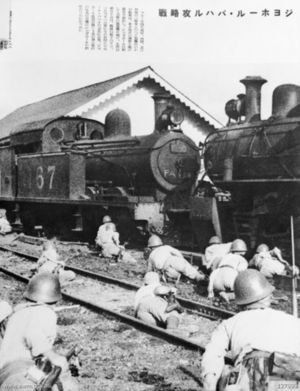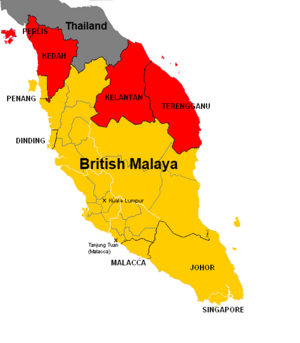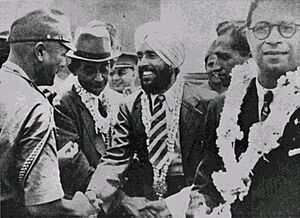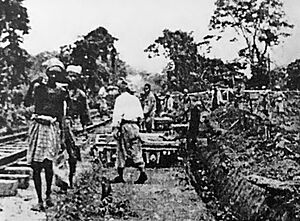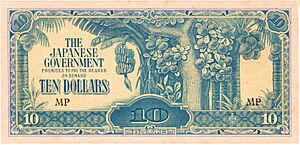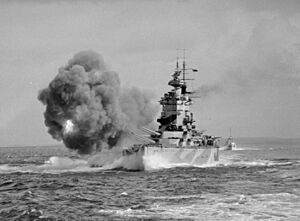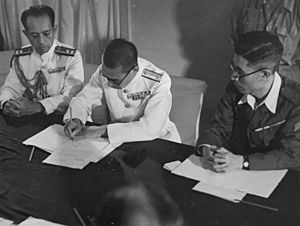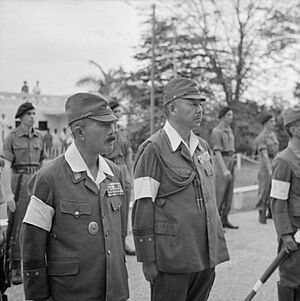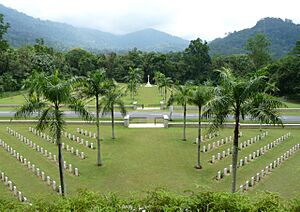Japanese occupation of Malaya facts for kids
Quick facts for kids
Japanese-occupied Malaya
Malai (マライ, Marai)
|
|||||||||||||||
|---|---|---|---|---|---|---|---|---|---|---|---|---|---|---|---|
| 1941–1945 | |||||||||||||||
|
Motto: 八紘一宇 (Hakkō Ichiu)
("Eight Crown Cords, One Roof") |
|||||||||||||||
|
Anthem: 君が代 (Kimigayo)
("His Imperial Majesty's Reign") |
|||||||||||||||

Japanese possessions of British Malaya in 1942
|
|||||||||||||||
| Status | Military occupation by the Empire of Japan | ||||||||||||||
| Capital | None (de jure) Singapore (de facto, 1942–1944) Taiping (de facto, 1944–1945) |
||||||||||||||
| Common languages | Japanese English Malay Chinese Tamil |
||||||||||||||
| Government | Military occupation | ||||||||||||||
| Emperor | |||||||||||||||
|
• 1941–1945
|
Shōwa | ||||||||||||||
| Historical era | World War II | ||||||||||||||
|
• Pacific War begins
|
8 December 1941a | ||||||||||||||
|
• Japanese troops land on Kota Bharu
|
8 December 1941 |
||||||||||||||
|
• British troops retreat to Singapore
|
31 January 1942 | ||||||||||||||
|
• Four states to Thailand
|
18 October 1943 | ||||||||||||||
| 15 August 1945 | |||||||||||||||
|
• British Military Administration set up
|
12 September 1945 |
||||||||||||||
|
• Formation of Malayan Union
|
1 April 1946 |
||||||||||||||
| Currency | Japanese-issued dollar ("Banana money") | ||||||||||||||
|
|||||||||||||||
| Today part of | Malaysia | ||||||||||||||
|
|||||||||||||||
Malaya, which was controlled by the British, was taken over by Japanese forces. This happened gradually between December 8, 1941, and February 16, 1942. The Japanese stayed in control until they surrendered to the Allied forces in 1945. The first Japanese soldiers in Malaya to give up were in Penang on September 2, 1945. This happened aboard the British ship HMS Nelson.
Contents
Why Japan Invaded Malaya
Japan had a big idea called the "Greater East Asia Co-Prosperity Sphere." This idea was about creating a group of Asian countries led by Japan. They wanted to free Asia from Western colonial rule. Japanese leaders believed Asia should be for Asians.
When World War II started in Europe, Japan saw a chance. European powers were busy fighting in Europe. This made it hard for them to stop Japan in Asia. Japan wanted to remove European influence and control resources in Asia.
Japan also needed many materials for its military, especially oil. The United States, United Kingdom, and Netherlands stopped supplying oil to Japan. This was to make Japan stop its war in China. But Japan decided to attack these countries' territories in Southeast Asia instead.
How Japan Prepared for Invasion
Japanese military units secretly gathered information about Malaya. They used spies, business people, and even some unhappy locals. This information helped them plan their attack.
One important spy was Captain Patrick Stanley Vaughan Heenan. He was a British intelligence officer who helped Japan. His information allowed the Japanese to destroy many Allied planes on the ground.
Japanese officers also worked with groups in Malaya and India that wanted independence from British rule. These groups, like Kesatuan Melayu Muda in Malaya, gave Japan information. In return, Japan offered them financial support.
By 1941, Japanese troops were ready. They gathered on Hainan Island and in French Indochina. The Allies noticed this build-up. Japan claimed it was for their war in China.
The Japanese Conquest of Malaya
The Japanese invasion began just after midnight on December 8, 1941. Japanese soldiers landed at Padang Pak Amat beach in Kota Bharu. This started a fierce fight with the British Indian Army. This battle happened an hour before the attack on Pearl Harbor. It marked the start of the Pacific War and the Japanese occupation of Malaya.
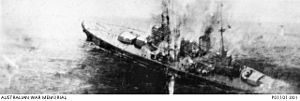
The Japanese quickly captured airports like Kota Bharu, Sungai Patani, Butterworth, and Alor Star. They bombed Penang on December 11. British forces had to retreat south. Penang fell to the Japanese on December 19.
The Japanese continued their advance, taking Ipoh on December 26. There was strong resistance at the Battle of Kampar. This battle lasted three days and nights. But the British had to retreat again.
On January 7, 1942, the Japanese defeated British forces at the Battle of Slim River. This opened the way to Kuala Lumpur, the capital of Malaya. Kuala Lumpur was captured on January 13.
The British tried to set up a new defense line in north Johor. Australian soldiers fought bravely at Gemas on January 14. But the Japanese were too strong. The Johor defense line collapsed.
By January 31, 1942, all of Malaya was under Japanese control. The Allied forces had to retreat across the Johor Causeway to Singapore.
Life Under Japanese Rule
Japanese Policies and Changes
Once Malaya was taken, it was placed under Japanese military control. The Japanese aimed to get important materials for their war. They also wanted to restore order. They respected local customs at first.
The Japanese treated the Chinese population very harshly. This was because the Chinese had supported China against Japan. Malays and Indians were treated more moderately. This was because they cooperated more with the Japanese.
The Japanese wanted to change Malaya's main language to Japanese. They changed shop signs and street names. Penang was renamed Tōjō Island. Malaya itself was called Malai. The time zone was also changed to match Japan's. People were expected to bow to Japanese soldiers.
Propaganda and Newspapers
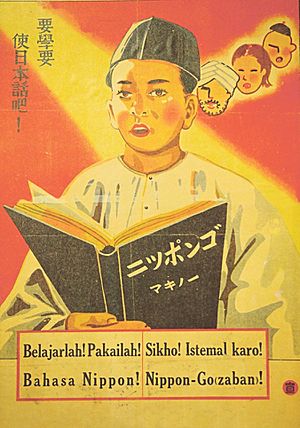
The Japanese used slogans like "Asia for Asians" to gain support. They told locals that Japan was saving Malaya from British rule. They said Britain only wanted to exploit Malaya's resources.
The Japanese news agency, Dōmei Tsushin, controlled all news in Malaya. Newspapers like the Penang Shimbun were created. They combined Malay, Chinese, and English newspapers.
Military Control and Police
The Japanese Army was in charge of Malaya. The Kempeitai (Japanese military police) maintained public order. They could arrest and question anyone, using torture if they wished. The local police had to obey them.
Penang Submarine Base
During the occupation, Penang became an important submarine base. Japanese, Italian, and German submarines used it. It was a place for them to refuel and launch operations in the Indian Ocean.
German and Italian submarines started using Penang in early 1943. This base was the only one used by all three Axis navies. These submarines carried important war supplies between Germany and Japan.
By 1944, the base faced problems. It was running short on supplies. Allied anti-submarine patrols were a growing threat. The Japanese moved their submarines out of Penang. The Germans left later in December 1944.
Thai Control of Northern States
Before 1909, Kedah, Perlis, Kelantan, and Terengganu were part of Thailand. In 1909, they were transferred to British control.
In July 1943, Japan's Prime Minister Hideki Tojo announced a change. These four states would be given back to Thailand. This was part of a military alliance between Thailand and Japan. Thailand controlled these states from October 18, 1943, until the end of the war.
Daily Life and Hardships
Recruiting and Independence Movements
The Japanese tried to get support from Indian and Malay people. They wanted them to help the Japanese war effort.
A Japanese officer, Major Iwaichi Fujiwara, worked with the Indian Independence League. He convinced Major Mohan Singh to form the Indian National Army (INA). This army was made of Indian soldiers captured by the Japanese. They wanted to free India from British rule. After Singapore fell, the INA grew to 40,000 volunteers.
Fujiwara also connected with Ibrahim Yaacob of Kesatuan Melayu Muda. This was a Malay group that wanted independence. They helped the Japanese, hoping Japan would grant Malaya independence. However, Japan refused and disbanded the group. Instead, they formed a militia called Pembela Tanah Ayer (PETA).
Hardships Faced by People
The Japanese forced the Chinese community to pay a large sum of money. This was seen as punishment for supporting China's war effort.
Many Malayans were forced to work on the Thai-Burma Railway. About 73,000 Malayans were forced to work there. An estimated 25,000 of them died. The Japanese also took railway tracks from Malaya for this project.
As the war continued, everyone suffered. There was severe rationing of food and supplies. Prices went up very quickly (hyper-inflation). Allied forces blocked Japanese-occupied areas. This made it hard for Japan to bring in supplies.
Both Malays and Indians faced more problems with the Japanese. This led more people to join resistance movements.
Economy and Money
Malaya used to produce a lot of rubber and tin for the world. But during the occupation, Japan could not use all of it. Also, Malaya could not sell its goods to other countries. This caused incomes to drop.
The Japanese replaced the Malayan dollar with their own currency. They printed a lot of this money. This caused prices to skyrocket. By the end of the war, the Japanese money became almost worthless. The Allies even dropped leaflets telling people the Japanese money would become useless.
Resistance Against Japan
After the Japanese invaded, the British allowed the Malayan Communist Party (MCP) to fight back. They trained MCP members in guerrilla warfare. These fighters formed the Malayan Peoples' Anti-Japanese Army (MPAJA). They carried out sabotage and ambushes against the Japanese.
The Japanese responded by punishing Chinese civilians. This made many Chinese people flee to the forests. They became the main supporters of the MPAJA.
A British agent named Lai Teck had secretly joined the MCP. He was arrested by the Japanese and became a double agent. He gave information to the Japanese. Because of him, the Japanese attacked a secret meeting of MCP and MPAJA leaders. Most of them were killed.
Later, British commandos from Force 136 came to Malaya. They worked with the guerrillas. In 1944, they agreed that the Allies would give the MPAJA weapons and supplies.
Another resistance group was the Pahang Wataniah. It was formed by Yeop Mahidin. This group protected the Sultan of Pahang from the MPAJA after the war ended.
Allied Actions During Occupation
Strategic Bombing Raids
The Allies carried out bombing raids against Japanese targets in Malaya. The first major bombing was on February 2, 1942. American planes attacked airfields in Kuantan and Kuala Lumpur.
Later, in late 1944, British B-24 Liberator planes dropped mines in the Penang Strait. This made it hard for Japanese submarines to use the area.
American B-29 bombers attacked Penang on January 11, 1945. They also attacked Kuala Lumpur's railway yards and Alor Star airfield. Some bombs accidentally hit the Royal Selangor museum.
Some Allied soldiers and civilians hid in the jungle. They joined resistance groups like the MPAJA. Others, like Freddie Spencer Chapman, were secret agents. They tried to sabotage Japanese forces.
Allied navy units, especially submarines, attacked Japanese ships. They also brought Force 136 agents to Malaya. Allied planes supplied the resistance with weapons.
In May 1945, a British task force sank the Japanese cruiser Haguro in the Battle of the Malacca Strait.
The Allies planned a big invasion of Malaya called Operation Zipper. This was to liberate Singapore. But the war ended before this operation could begin.
The End of the Occupation
On August 15, 1945, Emperor Hirohito of Japan announced that Japan would surrender. British planes then flew over Malayan cities, dropping leaflets about the surrender.
After the surrender announcement, there was some fighting. This happened between Chinese and Malay communities, especially in Perak. The MPAJA attacked people they thought had helped the Japanese.
Penang was the first state in Malaya to be freed. The Japanese soldiers in Penang surrendered on September 2, 1945. British Royal Marines took back Penang Island the next day.
Singapore was recaptured on September 12. After that, British forces reached Kuala Lumpur. The Japanese commander there surrendered on September 13, 1945. Another surrender ceremony was held in Kuala Lumpur on February 22, 1946.
On September 12, 1945, the British Military Administration (BMA) took control in Kuala Lumpur. The MPAJA later agreed to give up their weapons and disband.
After the War
Repatriation of Japanese Troops
Japanese soldiers who were still in Malaya were sent to islands like Rempang and Galang Island. They waited there to be sent back to Japan. More than 200,000 Japanese troops passed through these islands. The last troops left in July 1946.
About 7,000 Japanese civilians who lived in Malaya were also sent back to Japan.
War Graves and Memorials
Cemeteries were created for Malayan and Allied soldiers who died. These include Kranji War Cemetery in Singapore and Taiping War Cemetery in Taiping, Perak.
The main national war memorial in Malaysia is the National Monument in Kuala Lumpur. It honors those who served in World War II and the Malayan Emergency that followed.
Independence Movement
The Japanese occupation greatly affected Malaya. It helped spark a stronger desire for independence from British rule.
See also
- Battle of Malaya
- Battle of Borneo (1941–42)
- Borneo campaign (1945)
- Battle of North Borneo
- Japanese invasion of Malaya
- Japanese occupation of Singapore
- Japanese occupation of British Borneo
- Sook Ching massacre
- Weeratunge Edward Perera
- British Military Administration (Malaya)
- Collaboration with Imperial Japan
- Greater East Asia Co-Prosperity Sphere




